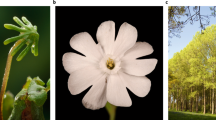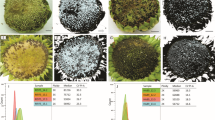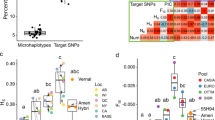Summary
The selective forces responsible for the evolution of gametophytic apomixis in outbreeding plant populations are analysed in terms of a simple single gene model. In the absence of selection, apomixis inevitably becomes fixed in a population. This conclusion holds regardless of the dominance relations of the alleles specifying apomictic versus sexual seed formation. Substantial heterotic viability selection is required to prevent fixation of recessive and codominant apomictic alleles and maintain a stable polymorphism at the mating system locus. These findings suggest that gametophytic apomixis should be a common mode of reproduction in plant species. Possible factors accounting for the relative paucity of apomictic plants are discussed. It is concluded that one of the major factors hindering the spread of apomixis is its usually complex inheritance and the need to accumulate, in the one individual, two or more mutations affecting meiosis and the reproductive system.
Similar content being viewed by others
Article PDF
References
Asher, J H. 1970. Parthenogenesis and genetic variability. II. One locus models for various diploid populations. Genetics, 66, 369–391.
Asker, S. 1979. Progress in apomixis research. Hereditas, 91, 231–240.
Battagalia, E. 1963. Apomixis. In Recent Advances in the Embryology of Angiosperms, ed. P. Maheshwari, 467 pp. International Society of Plant Morphologists, University of Delhi.
Casady, A J, Heyne, E G, and Weibel, D E. 1960. Inheritance of female sterility in sorghum. J Hered, 51, 35–38.
Charlesworth, B. 1980. The cost of sex in relation to mating system. J Theoret Biol. 84, 655–671.
Clausen, J. 1954. Partial apomixis as an equilibrium system in evolution. Caryologia Suppl, 6, 469–479.
Crosby, J L. 1949. Selection of an unfavourable gene complex. Evolution, 3, 212–230.
Crow, J F, and Kimura, M. 1965. Evolution in sexual and asexual populations. Amer Nat, 99, 439–450.
Crow, J F, and Kimura, M. 1969. Evolution in sexual and asexual populations: A reply. Amer Nat, 103, 89–91.
Darlington, C D. 1939. The Evolution of Genetic Systems. Cambridge University Press, Cambridge.
De Wet, J M, and Stalker, H T. 1974. Gametophytic apomixis and evolution in plants. Taxon, 23, 689–697.
Fisher, R A. 1930. The Genetical Theory of National Selection. Clarendon Press, Oxford.
Fisher, R A. 1941. Average excess and average effect of a gene substitution. Ann Eugen, 11, 53–63.
Frankel, R, and Galun, E. 1977. Pollination mechanisms, Reproduction and Plant Breeding. Springer-Verlag, New York.
Grant, V. 1971. Plant Speciation, 435 pp. Columbia University Press, New York.
Gustafsson, A. 1946. Apomixis in the higher plants. I. The mechanism of apomixis. Lunds Univ Arsskr, 43, 1–66.
Gustafsson, A. 1947a. Apomixis in higher plants. II. The causal aspect of apomixis. Lunds Univ Arsskr, 43, 71–178.
Gustaffson, A. 1947b. Apomixis in higher plants. III. Biotype and species formation. Lunds Univ Arsskr, 44, 183–370.
Hanna, W W, Schertz, K F, and Bashaw, E C. 1970. Apospory in Sorghum bicolor (L.) Moench. Science, 170, 338–339.
Hayman, B I. 1953. Mixed seifing and random mating when homozygotes are at a disadvantage. Heredity, 7, 185–192.
Hayman, B I, and Mather, K. 1953. The progress of inbreeding when homozygotes are at a disadvantage. Heredity, 7, 165–183.
Heslop-Harrison, J. 1961. Apomixis, environment and adaptation. In Recent Advances in Botany, Vol. I, pp. 891–895. Proc. 9th. Int. Bot. Cong., University of Toronto Press.
Jain, S K. 1976. The evolution of inbreeding in plants. Ann Rev Ecol Syst, 7, 469–495.
Jain, S K, and Workman, P L. 1967. Generalized F statistics and the theory of inbreeding and selection. Nature, 214, 674–678.
Knox, R B. 1967. Apomixis. Seasonal and population differences in a grass. Science, 157, 325–326.
Knox, R B, and Heslop-Harrison, J. 1963. Experimental control of aposporous apomixis in a grass of the Andropogoneae. Botaniska Natiser, 116, 127–141.
Lloyd, D G. 1977. Genetic and phenotypic models of natural selection. J Theor Biol, 69, 543–560.
Mather, K. 1973. Genetical Structure of Populations, 197 pp. Chapman and Hall, London.
Marshall, D R, and Brown, A H D. 1974. Estimation of the level of apomixis in plant populations. Heredity, 32, 321–333.
Marshall, D R, and Downes, R W. 1977. A test for obligate apomixis in grain sorghum R473. Euphytica, 26, 661–664.
Marshall, D R, and Weir, B S. 1979. Maintenance of genetic variation in apomictic plant populations. I. Single locus models. Heredity, 42, 159–172.
Maynard Smith, J. 1968. Evolution in sexual and asexual populations. Amer Nat, 102, 469–473.
Maynard Smith, J. 1971a. What use is sex? J Theoret Biol, 30, 319–335.
Maynard Smith, J. 1971b. The origin and maintenance of sex. In Group Selection, ed. G. C. Williams Aldine-Atherton, pp. 163–175. Chicago.
Maynard Smith, J. 1976. A short-term advantage for sex and recombination through sib-competition. J Theor Biol, 63, 245–258.
Maynard Smith, J. 1977. The sex habit in plants and animals. Lecture Notes in Bio-mathematics, 19, 315–331, eds. F. B. Christiansen and T. M. Fenchel. Springer-Verlag, New York.
Maynard Smith, J. 1978. The Evolution of Sex, 222 pp. Alden Press, Oxford.
Moran, P A P. 1962. The Statistical Processes of Evolutionary Theory. Clarendon Press, Oxford.
Muller, H J. 1932. Some genetic aspects of sex. Amer Nat, 8, 118–138.
Nygren, A. 1954. Apomixis in angiosperme. II. Bot Rev, 20, 577–649.
Nygren, A. 1967. Apomixis in the angiosperms. Handb der Pflanzenphys, 18, 551–596.
Powers, L. 1945. Fertilization without reduction in guayule (Parthenium argentatum Gray) and a hypothesis as to the evolution of apomixis and polyploidy. Genetics, 30, 323–346.
Saran, S, and De Wet, J M J. 1970. The mode of reproduction in Dicanthium intermedium (Gramineae). Bull Torry Bot Club, 97, 6–13.
Stebbins, G L. 1941. Apomixis in the angiosperms. Bot Rev, 10, 507–542.
Stebbins, G L. 1950. Variation and Evolution in Plants, 643 pp. Columbia University Press, New York.
Williams, G C. 1975. Sex and Evolution. Princeton University Press, Princeton N.J.
Williams, G C, and Mitton, J B. 1973. Why reproduce sexually? J Theoret Biol, 39, 545–554.
Workman, P L, and Jain, S K. 1966. Zygotic selection under mixed random mating and self-fertilisation: Theory and problems of estimation. Genetics, 54, 159–171.
Author information
Authors and Affiliations
Rights and permissions
About this article
Cite this article
Marshall, D., Brown, A. The evolution of apomixis. Heredity 47, 1–15 (1981). https://doi.org/10.1038/hdy.1981.54
Received:
Issue date:
DOI: https://doi.org/10.1038/hdy.1981.54
This article is cited by
-
Australian Senecio macrocarpus and S. squarrosus were suggested as apomictic but are fully sexual: evidence from flow cytometric seed screening analyses
Plant Systematics and Evolution (2024)
-
The Female Gametophyte Characteristics and Gene Expression Analysis Involved in Apomixis of Wild Germplasm Materials of Kentucky Bluegrass in Gansu Province of China
Journal of Plant Growth Regulation (2023)
-
Is ploidy status related to growth form? Insights from the alien flora of Kashmir Himalaya
Acta Physiologiae Plantarum (2021)
-
Genetic homogeneity of a recently introduced pathogen of chickpea, Ascochyta rabiei, to Australia
Biological Invasions (2015)
-
Evolution of gametophytic apomixis in flowering plants: an alternative model from Maloid Rosaceae
Theory in Biosciences (2009)



